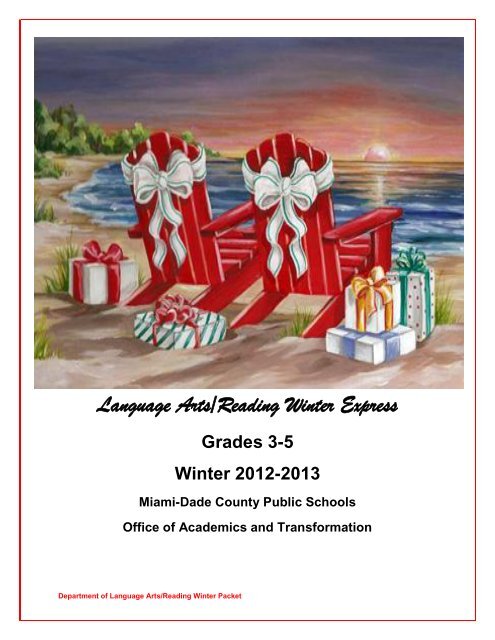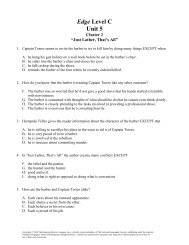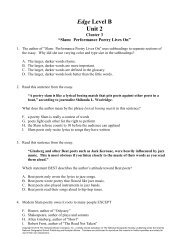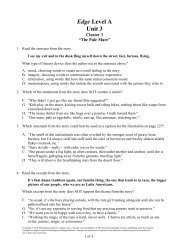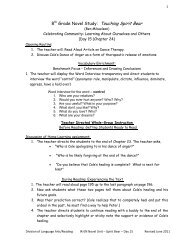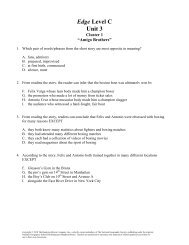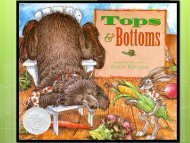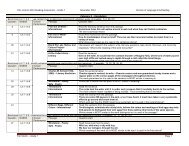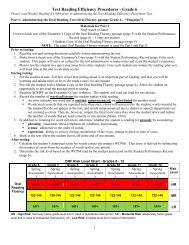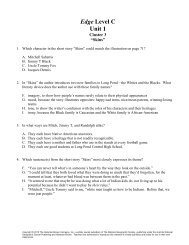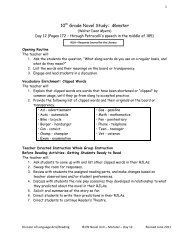Grades 3-5 - Division of Language Arts/Reading - Miami-Dade ...
Grades 3-5 - Division of Language Arts/Reading - Miami-Dade ...
Grades 3-5 - Division of Language Arts/Reading - Miami-Dade ...
You also want an ePaper? Increase the reach of your titles
YUMPU automatically turns print PDFs into web optimized ePapers that Google loves.
<strong>Language</strong> <strong>Arts</strong>/<strong>Reading</strong> Winter Express<strong>Grades</strong> 3-5Winter 2012-2013<strong>Miami</strong>-<strong>Dade</strong> County Public SchoolsOffice <strong>of</strong> Academics and TransformationDepartment <strong>of</strong> <strong>Language</strong> <strong>Arts</strong>/<strong>Reading</strong> Winter Packet
THE SCHOOL BOARD OF MIAMI-DADE COUNTY, FLORIDAPerla Tabares Hantman, ChairDr. Martin Karp, Vice ChairDr. Dorothy Bendross-MindingallSusie V. CastilloCarlos L. CurbeloDr. Lawrence S. FeldmanDr. Wilbert “Tee” HollowayDr. Marta PérezRaquel A. RegaladoJude BrunoStudent AdvisorAlberto M. CarvalhoSuperintendent <strong>of</strong> SchoolsMilagros R. FornellChief Academic OfficerOffice <strong>of</strong> Academics and TransformationMarie L. IzquierdoAssistant SuperintendentAcademics, Accountability and School ImprovementOffice <strong>of</strong> Academics and TransformationKaren SpiglerAdministrative DirectorDepartment <strong>of</strong> <strong>Language</strong> <strong>Arts</strong>/<strong>Reading</strong>Department <strong>of</strong> <strong>Language</strong> <strong>Arts</strong>/<strong>Reading</strong> Winter Packet
Table <strong>of</strong> ContentsWelcome to the <strong>Language</strong> <strong>Arts</strong>/<strong>Reading</strong> Winter Express ...................................................... 4Winter Celebrations Throughout the World ............................................................................ 7Which Holiday Do You Celebrate – Cube Activity ................................................................ 11A Tourist in Your Own Town ................................................................................................ 12Vocabulary- Christmas Around the World ............................................................................ 13Winter Solstice ..................................................................................................................... 14Loved the Book…Not Sure About the Movie ........................................................................ 16Read in the New Year .......................................................................................................... 18Department <strong>of</strong> <strong>Language</strong> <strong>Arts</strong>/<strong>Reading</strong> Winter Packet
Welcome to the <strong>Language</strong> <strong>Arts</strong>/<strong>Reading</strong>Winter ExpressThe purpose <strong>of</strong> the Winter Express is to have your child experience qualityliterature and various reading explanations while school is out for winterbreak. Attached you will find a list <strong>of</strong> appropriate grade-level books thatcan be found in the public library, reading excerpts, and grade levelactivities that may be used to enhance the winter reading experience forstudents. The reading materials and activities are reflective <strong>of</strong> differentlearning styles, and guide students in applying concepts they have studied.Activities address and are aligned with State Standards and Common CoreState Standards providing continuous opportunities for our students tomove along a continuum <strong>of</strong> learning experiences that will empower andbuild their confidence as learners.We encourage both students and parents to participate and make thiswinter reading experience fun and enjoyable for the whole family.Department <strong>of</strong> <strong>Language</strong> <strong>Arts</strong>/<strong>Reading</strong> Winter Packet
Third GradeLA.3.2.1.2 Elements <strong>of</strong> Story Structure – Character, Character Development, Setting,Plot, Problem/Solution. (RL.3.3, RL.3.6)LA.3.1.7.3 Main idea, relevant supporting details, strongly implied message, inference,and chronological order. (RL.3.1, RI.3.1, RI.3.2)LA.3.1.7.2 Identify the author’s purpose (e.g., to inform, entertain, or explain) in text andhow an author’s perspective influences text. (RL.3.6, RI.3.6)LA.3.1.7.6 Identify themes or topics across a variety <strong>of</strong> fiction an non-fiction selections.(RL.3.9, RI.3.9)LA.3.1.7.5 Identify the text structure an author uses (e.g., comparison/contrast,cause/effect, and sequence <strong>of</strong> events) and explain how it impacts meaning in text.(RI.3.3, RI.3.8)LA.3.4.2.4 Write a variety <strong>of</strong> communications (e.g., friendly letter, thank-you notes,formal letters, messages, invitations) (W.3.2, W.3.2a, W3.2b, W.3.2c, W.3.2.d, W.3.10)LA.3.4.2.1 Write in a variety <strong>of</strong> informational/expository forms (e.g., rules, summaries,procedures, recipes, notes/messages, labels, instructions, graphs/tables, experiments,rubrics) (W.3.2, W.3.2a, W3.2b, W.3.2c, W.3.2.d, W.3.10)LA.3.3.1.1 Generating ideas from multiple sources (e.g., text, brainstorming, graphicorganizer, drawing, writer’s notebook, group discussion, printed material) (W.3.2a,W.3.5Fourth GradeLA.4.1.7.6 Identify themes or topics across a variety <strong>of</strong> fiction and non-fiction selectionsLA.4.1.7.7 Compare and contrast elements in multiple texts (e.g., setting, characters,problems)LA.4.2.1.2 Identify and explain the elements <strong>of</strong> plot structure, including exposition,setting, character development, problem/resolution, and theme in a variety <strong>of</strong> fictionLA.4.1.7.3 Determine explicit ideas and information in grade-level text, including but notlimited to main idea, relevant supporting details, implied message, inferences,chronological order <strong>of</strong> events, summarizing, and paraphrasingLA.4.6.1.1 Read informational text and text features (e.g., format, graphics, legends,illustrations, diagrams) to organize information for different purposes (e.g. beinginformed, following multi-step directions, creating a report, conducting interviews,preparing to take a test, performing a taskLA.4.4.2.3 Write informational/expository essays that contain introductory, body, andconcluding paragraphsLA.4.3.1.2 Determining the purpose (e.g., to entertain, to inform, to communicate, topersuade) and the intended audience <strong>of</strong> a writing piece)Fifth GradeDepartment <strong>of</strong> <strong>Language</strong> <strong>Arts</strong>/<strong>Reading</strong> Winter Packet
LA.5.1.7.2 Identify the author’s purpose (e.g., to persuade, inform, entertain, explain)and how an author’s perspective influences textLA.5.1.7.3 Determine the main idea or essential message in grade-level text throughinferring, paraphrasing, summarizing, and identifying relevant detailsLA.5.1.7.8 Use strategies to repair comprehension <strong>of</strong> grade-appropriate text when selfmonitoringindicates confusion, including but not limited to rereading, checking contextclues, predicting, note-making, summarizing, using graphic and semantic organizers,questioning, and clarifying by checking other sourceLA.5.4.2.3 Write informational/expository essays that state a thesis with a narrow focus,contain introductory, body, and concluding paragraphDepartment <strong>of</strong> <strong>Language</strong> <strong>Arts</strong>/<strong>Reading</strong> Winter Packet
Winter Celebration throughout the WorldJunkanoo is a street parade with music which occurs in many towns across the Bahamas,United Kingdom, Hong Kong, Australia, Canada, New Zealand, and some otherCommonwealth nations. It is traditionally celebrated every Boxing Day, the day followingChristmas Day, December 26 th . It is believed that this festival began during the 16 th and 17 thcenturies. The slaves in The Bahamas were given a special holiday around Christmas time,when they would be able to leave the plantations to be with their family and celebrate theholidays with African dance, music, and costumes. This tradition has continued andJunkanoo has evolved from its simple origins to a more formal, organized parade withsophisticated, intricate costumes, themed music and prizes. It is a celebration where peoplewear masks and dance to music in the streets beginning at 2 am and ending at dawn.Kwanzaa is a celebration that has its roots in the Black Nationalist movement <strong>of</strong> the1960’s and was established as a means to help African Americans reconnect with theirAfrican cultural and historical heritage. It was created by Maulana Karenga and firstcelebrated in 1966-1967. Traditionally it is observed from December 26 to January 1culminating in a feast and gift-giving celebration. This is a week-long celebration heldin the United States and Canada, and each day represents one <strong>of</strong> the seven coreprinciples (Nguzo Saba) unity, self-determination, collective work and responsibility,cooperative economics, purpose, creativity, and faith.Chanukkah: One <strong>of</strong> the most popular Jewish holidays, not for its religious significance,but for its proximity to Christmas. The history <strong>of</strong> Chanukkah is the celebration <strong>of</strong> arevolution against assimilation and the suppression <strong>of</strong> Jewish religion. It is celebratedfrom December 26 to January 1 with the tradition <strong>of</strong> the lighting <strong>of</strong> the menorah, aseries <strong>of</strong> seven candles.Chanukkah celebrates two things: a miracle in which one day’s worth <strong>of</strong> oil burned foreight days, and the victory <strong>of</strong> the Jewish freedom fighters over the Syrian-Greek forcesthat tried to wipe out Judaism in the second century B.C.E. Chanukkah marks the veryfirst battle fought neither for territory, nor for conquest <strong>of</strong> another people, but inorder to achieve religious freedom. In larger sense, then Chanukkah celebrates areaffirmation <strong>of</strong> freedom and a recommitment to the spiritual quest.Hogmany: A New Year’s Celebration in Germany from December 29 to January 1. It isfour nights <strong>of</strong> partying, celebrating the New Year. Every night there are differentactivities and events for people to enjoy. Hogmanay is the Scots word for the last day<strong>of</strong> the year and is synonymous with the celebration <strong>of</strong> the New Year (Gregoriancalendar) in the Scottish manner.Department <strong>of</strong> <strong>Language</strong> <strong>Arts</strong>/<strong>Reading</strong> Winter Packet
Winter Celebration throughout the WorldBodhi Day: In the world <strong>of</strong> Buddhism, an important day <strong>of</strong> celebration is December 8th.This is the day that many Buddhists celebrate Bodhi Day. Bodhi Day is the Buddhistholiday that commemorates the day that the historical Buddha, Siddhartha Gautauma(Shakyamuni), experienced enlightenment (bodhi).St. Nicholas Day is observed on December 6 and traditionally celebrated in NorthernEurope. Children are taught that Santa Claus is actually St. Nicholas, a Fourth Centurybishop known for his kindness. He had a reputation for secret gift-giving, such asputting coins in the shoes <strong>of</strong> those who left them out for him, and thus became themodel for Santa Claus.Traditional celebrations <strong>of</strong> Saint Nicholas Day in Northern Europe included gifts left inchildren's shoes (the origin <strong>of</strong> our American Christmas stockings). Good children receivetreats - candies, cookies, apples and nuts, while naughty children receive switches orlumps <strong>of</strong> coal. Sometimes coins were left in the shoes, reminiscent <strong>of</strong> the life-savingdoweries the saint provided. In some households the father <strong>of</strong> the family may dress upas Saint Nicholas on the eve <strong>of</strong> his feast. He comes in, sometimes with his sidekick,Krampus or Black Peter, and helps each child examine his conscience. He admonishesthe bad and rewards the good.Advent/Christmas: Advent is the beginning <strong>of</strong> the liturgical year for most churches in the Westerntradition. It begins on the fourth Sunday before Christmas day, which is the Sunday nearestNovember 30, and ends on Christmas Eve (December 24). If Christmas Eve is a Sunday, it iscounted as the fourth Sunday <strong>of</strong> Advent, with Christmas Eve beginning at sundown. The maincolor is purple, which represent royalty. Advent is a season observed in many WesternChristian churches as a time <strong>of</strong> expectant waiting and preparation for the celebration <strong>of</strong> theNativity <strong>of</strong> Jesus at Christmas. Advent is a Christian holiday that can be celebrated in thehome and/or in the church.Three Kings Day takes place on January 6 (12 days after Christmas). This is aChristian holiday in Mexico where children receive gifts instead <strong>of</strong> on Christmasday. It is a celebration that commemorates the Biblical story <strong>of</strong> the three kings,Caspar, Melchior and Balthasar, who followed the star <strong>of</strong> Bethlehem to bring giftsto the Christ child.Department <strong>of</strong> <strong>Language</strong> <strong>Arts</strong>/<strong>Reading</strong> Winter Packet
Winter Celebration throughout the WorldLunar New Year: A holiday celebrated for two weeks by the Chinese,Koreans, and Vietnamese, it takes place during the first three days <strong>of</strong> thefirst lunar moon (late January or early February). People dress up incostumes and exchange food and gifts.Japanese New Year: Celebrating the New Year is the biggest event in Japan. Omisoka is NewYear’s Eve in Japan. People spend a great deal <strong>of</strong> time cleaning and shopping to prepare forthe new year (much like spring cleaning in the United States) in order to get rid <strong>of</strong> the dirtypast and start the new year fresh and clean. Shogatsu is the celebration that takes place onNew Year’s day. People decorate their homes and give gifts <strong>of</strong> money and toys to childrenand greeting cards to family and friends.Las Posadas: Las Posadas is a nine-day celebration with origins in Spain, nowcelebrated chiefly in Mexico, Guatemala and parts <strong>of</strong> the Southwestern UnitedStates. This holiday takes place December 16 to December 24 in Mexico. InEnglish, it means “the Inn” and is a traditional Mexican festival which reenactsJoseph’s search for a room at the inn. Each Christmas season, a processionalcarrying a doll representing the Christ Child and images <strong>of</strong> Joseph and Maryriding a burro walks through the community streets.Eid-al-Adha: Eid al-Adha or Feast <strong>of</strong> Sacrifice is the most important feast <strong>of</strong> the Muslimcalendar. It is a three day feast that marks the end <strong>of</strong> the Hajj pilgrimage to Mecca.This is a Muslim holiday that begins on January 10. It commemorates Ibraham’s(Abraham) willingness to obey God by sacrificing his son, Ishmael. Muslims believeIshmael is the forefather <strong>of</strong> the Arabs.World Religion Day: This holiday takes place on January 15 and is celebrated bythose <strong>of</strong> the Baha’i religion. It originated in the United States and aims to fosterthe establishment <strong>of</strong> interfaith understanding and harmony by emphasizing thecommon denominators underlying all religions. The message <strong>of</strong> World ReligionDay is that mankind, which has stemmed from one origin, must now strivetowards the reconciliation <strong>of</strong> that which has been split up.Department <strong>of</strong> <strong>Language</strong> <strong>Arts</strong>/<strong>Reading</strong> Winter Packet
What other holidays are celebrated during the winter break? Research some <strong>of</strong> the followingcelebrations:NAME OF HOLIDAYJunkanooDESCRIPTION and PICTURE or ILLUSTRATIONKwanzaaChanukkahHogmanySt. Nicholas DayAdvent/ChristmasThree Kings DayEid-al-AdhaLunar New YearBodhi DayJapanese New YearLas PosadasWorld Religion DayDepartment <strong>of</strong> <strong>Language</strong> <strong>Arts</strong>/<strong>Reading</strong> Winter Packet
Holiday Celebration CubeCreate your holiday celebration cube labeling each side with the following topics (Name<strong>of</strong> celebration, Foods, Songs, Symbols, Colors, Family/Stories) make sure you providedescription for each topic.Department <strong>of</strong> <strong>Language</strong> <strong>Arts</strong>/<strong>Reading</strong> Winter Packet
A Tourist in Your Own TownMany times, we host out-<strong>of</strong>-town relatives and friends over the winter break. Other times, we simply stayat home rather than travel during the break. It isn’t necessary to sit at home and do nothing. There aremany wonderful attractions available for little or no cost right here in <strong>Miami</strong>-<strong>Dade</strong> County.Possible Attractions for Family Fun and Learning:Actors’ Playhouse at the MiracleTheatre305-444-9293www.actorsplayhouse.orgBiscayne Nature Center305-361-6767www.biscaynenaturecenter.orgBarnacle Historic State Park305-442-6866www.floridastateparks.org/thebarnacleDeering Estate305-235-1668www.deeringestate.orgBiscayne National Park305-230-1100www.nps.gov/bisc/Everglades National Park305-242-7700www.nps.gov/everFairchild Tropical Gardens305-667-1651www.fairchildgarden.org/Jewish Museum <strong>of</strong> Florida305-672-5044www.jewishmuseum.com<strong>Miami</strong> Children’s Museum305-373-5437www.miamichildrensmuseum.orgHaitian Heritage Museum305-371-5988www.haitianheritagemuseum.orgJungle Island305-400-7000www.jungleisland.com<strong>Miami</strong> Metrozoo305-251-0400www.miamimetrozoo.comHistoric Hampton House305-635-5130www.dadeheritagetrust.org<strong>Miami</strong> Science Museum305-646-4200www.miamisci.orgMuseum <strong>of</strong> Contemporary Art305-893-6211www.mocanomi.orgLocal Guide for Exploring <strong>Miami</strong> for Freehttp://miamiflonthecheap.com/cheap-fun-with-kids/<strong>Grades</strong> 3-5 ACTIVITES:Design a T-shirt to promote the place you have visited.Create an advertisement ad to promote the place you have visited.Poster- make a poster advertising the places you have visited to encouragesomeone else to visit there too.Department <strong>of</strong> <strong>Language</strong> <strong>Arts</strong>/<strong>Reading</strong> Winter Packet
VOCABULARY – CHRISTMAS AROUND THE WORLD1. How many ways can you say, “Merry Christmas and Happy New Year?” Look at thefollowing list and see if there are relationships between the words <strong>of</strong> one language andanother. What might explain the similarities and differences?Argentine - Feliz Navidad y Feliz Año NuevoBohemian - Vesele VanoceBrazilian - Boas Festas e Feliz Ano NovoBulgarian - Vesela Koleda i chestita nova godina!Catalan - Bon Nadal i un Bon Any Nou!Chinese - Sing Dan Fae Lok. Gung Hai Fat Choi (Cantonese)Chinese - Shen Dan Kuai Le Xin Nian Yu Kuai (Mandarin)Croatian - Sretan BozicCzech - Stastne a vesele vanoce a stastny novy rok!Danish - Glaedelig Jul og godt nyterDutch - Vrolijk Kerstfeest en een Gelukkig Nieuw JaarEnglish - Merry Christmas and a Happy New YearEskimo - (inupik) Jutdlime pivdluarit ukiortame pivdluaritlo!Filipinos - Maligayang PaskoFinnish - Hyvää joulua ja onnellista uutta vuotta!French - Joyeux Noel et Bonne Année!Scots Gaelic - Nollaig chridheil agus Bliadhna mhath yr!German - Frohe Weihnachten und ein gl|ckliches Neues Jahr!Hawaian - Mele Kalikimaka ame Hauoli Makahiki Hou!Hungarian - Kellemes karacsonyi uennepeket es boldog ujevet!Icelandic - Gledhileg jsl og farsflt komandi ar!Indonesian - Selamat Hari Natal dan Selamat Tahun Baru!Iraqi - Idah Saidan Wa Sanah JadidahIrish Gaelic - Nollaig Shona duitItalian - Buon Natale e Felice Anno Nuovo!Japanese - Meri Kurisumasu soshite Akemashite Omedeto!Latin - Natale hilare et Annum Faustum!Modern Greek - Kala Christougenna kai evtichismenos o kainourios chronos!Norwegian - God Jul Og Godt Nytt AarPolish - Vesowe Boze NarodzeniePortuguese - Feliz Natal e um Prospero Ano NovoRomanian - Craciun fericit si un an nou fericitRussian - S nastupaiushchim Novym godom i s Rozhdestvom Khristovym!Slovakian - Sretan Bozic or Vesele vianoceSpanish - Feliz Navidad y Próspero Año NuevoSwedish - God Jul Och Ett Gott Nytt ArThai - Suk san wan pee mai - Happy New YearTurkish - Noeliniz Ve Yeni Yiliniz Kutlu OlsunUkrainan - Z novym rokom i s rizdvom Hrystovym!Vietnamese - Chuc mung nam moi va Giang Sinh vui veWelsh - Nadolig Llawen a Blwyddyn Newydd Da!"Yoruba - E ku odun, e ku iye'dun!Department <strong>of</strong> <strong>Language</strong> <strong>Arts</strong>/<strong>Reading</strong> Winter Packet
Winter SolsticeMany holidays are centered around the winter solstice – the astronomical event <strong>of</strong> theWinter solstice, occurring sometime between December 20 and 23 each year in thenorthern hemisphere, and between June 20 and 23 in the Southern Hemisphere. It isthe shortest day and the longest night <strong>of</strong> the year, marking the beginning <strong>of</strong> winter whenthe sun is at its greatest distance from the equatorial plane. The name Winter Solsticemeans sun set still in winter.In Celtic countries such as Ireland the winter solstice is traditionally considered asmidwinter, the winter season beginning November 1 on All Hallows or Samhain. Winterends and spring begins on Imbolc or Candlemas, which is February 1 or 2. This system<strong>of</strong> seasons is based on the length <strong>of</strong> days exclusively. The three-month period <strong>of</strong> theshortest days and weakest solar radiation occurs during November, December andJanuary in the Northern Hemisphere (May-July in the Southern).Many Midwinter festivals have occurred according to lunar calendars and so, <strong>of</strong>ten tookplace on Höku night (Hawaiian), the night <strong>of</strong> the full moon closest to the winter solstice.And many solar calendar Midwinter celebrations still center upon December 25th in thenorth, which was the winter solstice upon the establishment <strong>of</strong> the Julian calendar.The difference between the Julian calendar year (365.2500 days) and the tropical year(365.2422 days) moved the day associated with the actual astronomical solstice forwardapproximately three days every four centuries until 1582 when Pope Gregory XIIIchanged the calendar bringing the northern winter solstice to around December 21st. Inthe Gregorian calendar the solstice moves around a bit but in the long term it movesonly about one day in 3000 years.YearJune SolsticeDecember SolsticeDay Time Day Time2007 21 18:06 22 06:082008 20 23:59 21 12:042009 21 05:45 21 17:472010 21 11:28 21 23:382011 21 17:16 22 05:302012 20 23:09 21 11:112013 21 05:04 21 17:112014 21 10:51 21 23:03Department <strong>of</strong> <strong>Language</strong> <strong>Arts</strong>/<strong>Reading</strong> Winter Packet
What special things might happen on or around the winter solstice? Write a storyabout something that happens (real or imagined) during this special time.Department <strong>of</strong> <strong>Language</strong> <strong>Arts</strong>/<strong>Reading</strong> Winter Packet
“Loved the Book…Not Sure About the Movie”3. Many movies that have been released are based on popular children’s andyoung adult books. The chart below highlights some <strong>of</strong> the more popularreleases. Read the book and then watch the movie. How is the story the sameor different? Is the dialogue the same in the movie as the book? Which do youlike better and why? Use the Venn diagram to identify similarities/differences,and provide a summary.Book Title – Date - AuthorBecause <strong>of</strong> Winn-Dixie (2000) – Kate DiCamilloCharlie and the Chocolate Factory (1963) – Roald DahlChronicles <strong>of</strong> Narnia (1950) – C. S. LewisHarry Potter and the Goblet <strong>of</strong> Fire (2000) – J. K.RowlingThe Nurse Matilda Stories (2002) – Christiana BrandOliver Twist – (1867) Charles DickensPride and Prejudice (1813) – Jane AustinA Sound <strong>of</strong> Thunder (1977) – Ray BradburyWar <strong>of</strong> the Worlds (1898) – H. G. WellsZathura: A Space Adventure (2002) – Chris VanAllsburgAlice in Wonderland (1865) – Lewis CarrollAll the King’s Men (1946) – Robert Penn WarrenBrideshead Revisited (1945) – Evelyn WaughCharlotte’s Web (1952) – E. B. WhiteCurious George (1941) – H. A. ReyMy Friend Flicka (1941) – Mary O’HaraHoot (2002) – Carl HiaasenHow to Eat Fried Worms (1973) – Thomas RockwellBridge to Terabithia (1977) – Katherine PatersonHarry Potter and the Order <strong>of</strong> the Phoenix (2003) – J. K.RowlingA Day with Wilbur Robinson (1990) – William JoyceThe Polar Express (1985), Chris Van AllsburgMovie TitleBecause <strong>of</strong> Winn-DixieCharlie and the Chocolate FactoryChronicles <strong>of</strong> Narnia: The Lion, theWitch and the WardrobeHarry Potter and the Goblet <strong>of</strong> FireNanny McPheeOliver TwistPride and PrejudiceA Sound <strong>of</strong> ThunderWar <strong>of</strong> the WorldsZathuraAliceAll the King’s MenBrideshead RevisitedCharlotte’s WebCurious GeorgeFlickaHootHow to Eat Fried WormsBridge to TeribithiaHarry Potter and the Order <strong>of</strong> thePhoenixMeet the RobinsonsThe Polar ExpressDepartment <strong>of</strong> <strong>Language</strong> <strong>Arts</strong>/<strong>Reading</strong> Winter Packet
Department <strong>of</strong> <strong>Language</strong> <strong>Arts</strong>/<strong>Reading</strong> Winter Packet
Recommended Books for Intermediate Age Readers Once Upon a Fairy Tale -Starbright Foundation Mr. Lincoln’s Way -Patricia Polacco The Shoe Tree <strong>of</strong> Chagrin -J. Patrick Lewis The Quiltmakers Gift -Jeff Brumbeau Miss Alaineus: A Vocabulary Disaster -Debra Frasier My America: A Poetry Atlas <strong>of</strong> the US -Lee BennettHopkins A Poke in the I- Paul B. Janeczko Three Days -Donna Jo NapoliDepartment <strong>of</strong> <strong>Language</strong> <strong>Arts</strong>/<strong>Reading</strong> Winter Packet
<strong>Reading</strong> Log/ActivitiesThird Grade<strong>Reading</strong> Log: Keep reading log/journal on the books read and make a list <strong>of</strong> wordsyou have learned. Write the new word, copy the sentence in which it is used, write adefinition using your own words, and draw a picture or symbol which reminds you whatthe word means.Book Title/Author New Vocabulary/Sentence Definition/ SymbolDepartment <strong>of</strong> <strong>Language</strong> <strong>Arts</strong>/<strong>Reading</strong> Winter Packet
Activities: Choose an additional activity <strong>of</strong> your choice from below for any <strong>of</strong> thebooks that you have read from the list that has been provided.Make a poster <strong>of</strong> your book so someone else will want to read it.Draw a portrait <strong>of</strong> the main character and write a summary to accompany yoursketch.Pick the most important word/line/image/object/event in the story and explainwhy you chose it. Be sure to support your choice with examples.Pick the most important word/line/image/object/event in the chapter and explainwhy you chose it. Be sure to support your choice with examples.Write a poem about one <strong>of</strong> the characters.Build a miniature stage setting <strong>of</strong> a scene in the book. Include a writtenexplanation <strong>of</strong> the scene.Create a Top Ten List. List ten things you have learned from the book.You are the reporter. Write a front page news story or a report live from thescene.Department <strong>of</strong> <strong>Language</strong> <strong>Arts</strong>/<strong>Reading</strong> Winter Packet
<strong>Reading</strong> Log/ActivitiesFourth Grade<strong>Reading</strong> Log: Keep reading log/journal on the books read and make a list <strong>of</strong> wordsyou have learned. Write the new word, copy the sentence in which it is used, write adefinition using your own words, and draw a picture or symbol which reminds you whatthe word means.Book Title/Author New Vocabulary/Sentence Definition/ SymbolDepartment <strong>of</strong> <strong>Language</strong> <strong>Arts</strong>/<strong>Reading</strong> Winter Packet
Activities: Choose an additional activity <strong>of</strong> your choice from below for any <strong>of</strong> thebooks that you have read from the list that has been provided.Create a dramatic monologue for a character in a scene. What are theythinking/feeling at that moment? Why?Write a one page “pitch” to a producer explaining why the story would or wouldnot make a great movie.Draw a multi-colored movie poster for the book. Put unusual movie informationon it. (who would you cast in the movie etc.)Create a collage around themes or characters in the book.Draw a map <strong>of</strong> the book’s setting and explain/Send a postcard from one <strong>of</strong> the characters. Draw a picture on one side; writethe message on the other.Write a poem about one <strong>of</strong> the characters.Create a Top Ten List. List ten things you have learned from the book.You are the reporter. Write a front page news story or a report live from thescene.Department <strong>of</strong> <strong>Language</strong> <strong>Arts</strong>/<strong>Reading</strong> Winter Packet
<strong>Reading</strong> Log/ActivitiesFifth Grade<strong>Reading</strong> Log: Keep reading log/journal on the books read and make a list <strong>of</strong> wordsyou have learned. Write the new word, copy the sentence in which it is used, write adefinition using your own words, and draw a picture or symbol which reminds you whatthe word means.Book Title/Author New Vocabulary/Sentence Definition/ SymbolDepartment <strong>of</strong> <strong>Language</strong> <strong>Arts</strong>/<strong>Reading</strong> Winter Packet
Activities: Choose an additional activity <strong>of</strong> your choice from below for any <strong>of</strong> thebooks that you have read from the list that has been provided.Write a character diary, writing at least five journal entries as if you are the maincharacter in the story. Write down events that happen during the story andreflect on how they affected the character and why.Create a timeline <strong>of</strong> the major events in your book. Use drawings or magazinecutouts to show the events along the timeline. Label each event.Design a poster to advertise your book. Be creative…use details…elaborate…use color! Try to make it 3-D or movable.Create a board game about a book you have read and play with family members.Build a miniature stage setting <strong>of</strong> a scene in the book. Include a writtenexplanation <strong>of</strong> the scene.Create a Top Ten List. List ten things you have learned from the book.You are the reporter. Write a front page news story or a report live from thescene.Write a poem about one <strong>of</strong> the characters.Department <strong>of</strong> <strong>Language</strong> <strong>Arts</strong>/<strong>Reading</strong> Winter Packet


